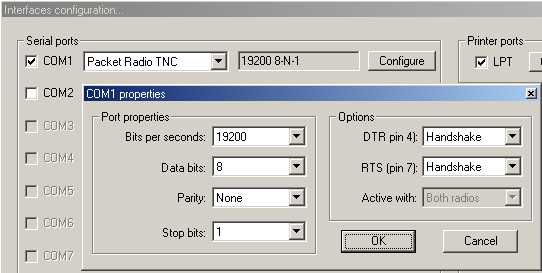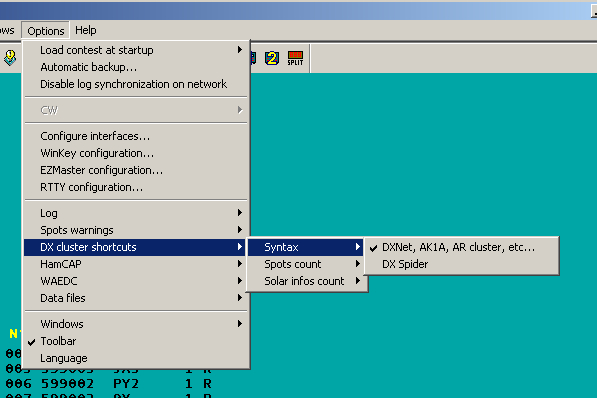DX Cluster/Packet
TNC pre-test
Before you can use a TNC with Win-Test, it should first be tested with a simple terminal program like Hyperterm provided with Windows. Do not try to get started with PAXON or other elusive software!
There are two types of TNC firmware: The TAPR flavor and the WA8DED flavor (often also called: The Firmware, TF). Both types allow switching the TNC into KISS mode, which is - however - not useful for our application.
When you turn on the TNC, the startup message will tell you, what kind of software you have.
TheFirmware or WA8DED
The following messages are displayed on a Symek TNC2H using TF mode:
TheFirmware Version 2.7 DAMA/SMACK/XHOST (2553 Bytes * 10 Channel)
Copyright by NORD><LINK, 14-Sep-94
Free for non-commercial usage
Checksum (CBCB) = CBCB
In TF mode, commands are sent to the TNC using [Escape] followed by a command character. [Escape] I for example will allow you to set the outgoing callsign and to connect to a station, use [Escape] C. Here is a sample session. When pressing the Escape key, the TNC displays an asterisk followed by a blank character.
* idl6rai * i * DL6RAI * * s1 * CHANNEL NOT CONNECTED * * cdb0pv * (1) CONNECTED to DB0PV *^G RMNC/FlexNet V3.3h - DB0PV/Muenchen - JN58SD - RU682 9600Bd FSK (G3RUH) =>c db0clx *** connected to DB0CLX Hallo Ben, hier ist db0clx mit Clx5.04. Cluster: 5 Links, 10 Nodes, 7 lokale Benutzer, max: 27. Letzter Start: 23-Jul-2006 0058Z - Laufzeit: 65.20:35:15 dl6rai de db0clx 26-Sep-2006 2133Z clx > q 73's Ben de db0clx *** reconnected to DB0PV =>q 73! * (1) DISCONNECTED fm DB0PV *^G
TAPR
TNCs in the TAPR mode, usually come up this way, or similar. Most characteristic for TAPR is the cmd: prompt. By the way, most TAPR TNCs use 7E1 COM port settings at 9600 baud, which is different from the typical 8N1 settings.
SYMEK GmbH DK9SJ TNC2 EPROM TAPR AX.25 Level 2 Vers 2.0 Release 1.1.8 30-08-92 32k Checksum $67 cmd:
At the cmd: prompt you are able to enter commands. Let's do a simple session in TAPR mode to make it clear.
cmd:mycall dl6rai MYCALL was NOCALL cmd:c db0pv cmd:*** CONNECTED to DB0PV RMNC/FlexNet V3.3h - DB0PV/Muenchen - JN58SD - RU682 9600Bd FSK (G3RUH) =>c db0clx *** connected to DB0CLX Hallo Ben, hier ist db0clx mit Clx5.04. Cluster: 5 Links, 10 Nodes, 7 lokale Benutzer, max: 27. Letzter Start: 23-Jul-2006 0058Z - Laufzeit: 65.20:37:40 dl6rai de db0clx 26-Sep-2006 2136Z clx > q 73's Ben de db0clx *** reconnected to DB0PV =>q 73! *** DISCONNECTED^@
Initially we set the outgoing and then connect. Note that the cmd: prompt goes away the moment you are connected.
Win-Test TNC set-up
To set-up TNC, open menu - options - configure interfaces. Setting up the right COM port parameters, the same as before in the terminal program.
Checking that the set-up works
To check that the TNC set-up and the connection are correct, open DX-Cluster monitor window (Alt+O). After resetting the TNC, the same message should appear as before in the terminal program. If it doesn't work, set-up or cable is wrong.
Connecting node
Once you have configured the appropriate COM port for your TNC in Win-Test, you should be able to connect to your local node.
Open the DX cluster window by using Alt+T to send a command to the TNC.
To control the TNC, you need control sequences. TNC control sequences always start with ESC!
Pressing ESC in the DX-Cluster window is not possible, the window will close.
To achieve an ESC control, you must press CTRL+E followed by the TNC command!
Check your call sign first, whether this is stored in the TNC correctly. If not, no connection is possible. To check your call sign type in DX cluster window: CTRL+E I
You can see the TNC answer in the monitor window, e.g.: NO CALL or CALL DL8NAS.
If your call sign is wrong, type: CTRL+E I <call> (CTRL+I DL8NAS)
After reset, the TNC is normally in channel 0, no connection is possible, only viewing mode. The command to change to channel 1 is: CTRL+E S1
Message in monitor window: CHANNEL NOT CONNECTED
The connect command to your local node: CTRL+E C<node> where <node> is the callsign of your local node.
You can follow the connection in the DX-cluster monitor window. When connection is made, then connect to your preferred DX-Cluster: It is important, that all commands after connecting are WITHOUT ESC! These are normal inputs in the DX-cluster window, e.g.: C DB0SDF-7 where C is the connect command to your local node, to connect to the DX cluster DB0SDF-7.
After connection to your preferred DX-cluster, you can use the buttons of the DX-CL window to show DX announcements.
You can use the packet monitor window (Alt+O) to check the connection status and to see data are coming in from the TNC. Spots should begin filling up the bandmap at this stage.
If no DX announcements come into the window, check also DX-Cluster options set-up:
Disconnecting node
To leave the DX cluster, use bye command in the DX-Cluster window. After reconnect to your local node, type the TNC command CTRL+E D to disconnect from your local node.
Other important TNC commands are:
CTRL+E T16: set TX delay, normally around 16 (12..20)
A summary of TNC commands set with TF OS can be found here: The Firmware TF 2.6 Commands
Sep. 25. 06, DL8NAS, Sigi


